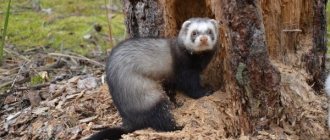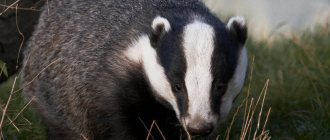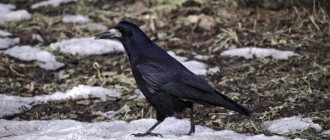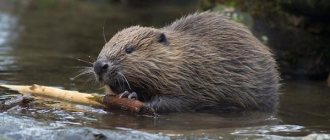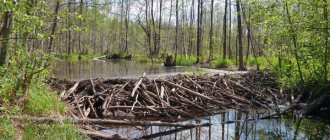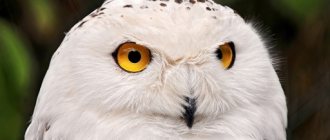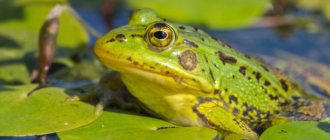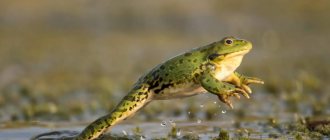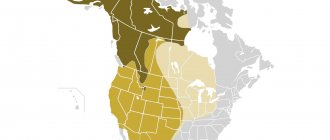20 December81273rodentsbeaver squad
The common beaver is a large semi-aquatic animal, a representative of the order Rodents. The common beaver is also called the river beaver. The beast amazes with his skills: he is an experienced builder, an excellent owner and an exemplary family man. The common beaver is the second largest rodent in the world. In this article you will find a description and photo of the common beaver and learn a lot of new and interesting things about these rodents.
Description of the rodent
— Advertising —
The beaver's body weight is about 30 kg, the body length reaches 1-1.5 m, females are usually slightly larger in size than males. The rodent has a blunt muzzle, small ears, short, strong legs with powerful claws. The beaver's fur consists of two layers: on top there are hard red-brown guard hairs, and underneath there is a thick gray undercoat that protects the beaver from hypothermia. The tail is bare, black, flattened and wide, covered with scales. Near the base of the tail are two glands that produce an odorous substance known as “beaver squirt.”
Environmental impact
Of all living animals, beavers have the greatest impact on the ecosystem around them. Only humans have a greater impact on the environment.
- Animal-built dams and lodges change the flow of rivers and streams, raise water levels and expand wetlands.
- Animals influence climate change and water temperature. In Arctic regions, floods caused by the animals lead to the melting of permafrost, which releases methane into the atmosphere.
- Flooding of land increases aquatic vegetation on average by a third.
- Waterlogging leads to an increase in the population of aquatic invertebrates living in stagnant water - dragonflies, snails, mussels, annelids. The number of aquatic invertebrates living in running water, on the contrary, is decreasing - midges, stoneflies and caddisflies are suffering.
- The presence of beavers leads to an increase in wild salmon and trout populations because the fish have more space to spawn, feed, and wait out the winter. The average size of fish is also increasing.
- Ponds with beavers attract many more birds, especially those that feed on fish. The number of ducks increases several times. Woodpeckers willingly nest in trees felled by animals.
- Beaver huts are actively used by other semi-aquatic animals - minks, otters, muskrats, and water rats.
- Deer and other large herbivores also benefit from the presence of beavers—their food supply increases with the growth of riparian vegetation and fallen trees and branches.
Beaver nutritional features
Beavers are herbivorous rodents. Their diet includes bark and shoots of trees (aspen, willow, poplar, birch), various herbaceous plants (water lily, egg capsule, iris, cattail, reed). They can also feed on hazel, linden, elm, and bird cherry. They readily eat acorns. Large teeth and a strong bite help beavers to eat fairly solid plant foods, and the microflora of their intestinal tract digests cellulose foods well.
The daily required amount of food reaches 20% of a beaver's weight.
— Advertising —
In the summer, the diet of beavers is dominated by grassy food; in the fall, rodents actively prepare woody food for the winter. Each family stores 60-70 m3 of wood. Beavers leave their reserves in the water, where they retain their food quality until the end of winter.
What does a beaver eat?
Beavers eat plant foods and are not picky eaters.
- In spring and summer, they feed mainly on green and herbaceous vegetation - leaves, roots, grass, sedge, water lilies, reeds, cattails and ferns.
- In winter, they mainly eat bark and cambium from trees; they prefer aspen, birch, oak, dogwood, willow and alder.
Animals often store food for the winter, creating a raft of trees in the part of the reservoir farthest from the shore. The upper part of the raft freezes, and the animals swim to it under the ice. However, it is not beaver populations that create rafts for the winter - some animals prefer to feed on the shore even in winter.
Common Beaver Species
Common or river beaver (Castor fiber)
The body length is 1-1.3 m, height is about 35.5 cm, weight is in the range of 30-32 kg. The body is squat, the paws are shortened with five fingers, the hind legs are stronger than the front ones. Swimming membranes are located between the fingers. The claws are strong and flat. The tail is paddle-shaped, flat, reaches 30 cm in length and 10-13 cm in width. The tail is pubescent only at the base, the rest of its surface is covered with horny scutes. The eyes are small, the ears are wide, short, and slightly protrude above the fur. Under water, the ears and nostrils close, and the eyes have special nictitating membranes. The common beaver has beautiful fur made up of coarse guard hairs and a thick, silky undercoat. The coat color ranges from light chestnut to dark brown, sometimes black. The tail and paws are black. Molting occurs once a year.
In the anal area there are paired glands, wen and the so-called “beaver stream”, the smell of which is a guide for other beavers, as it informs about the border of the family’s territory.
The common beaver is distributed in Europe (Scandinavian countries, France, Germany, Poland, Belarus, Ukraine), Russia, Mongolia and China.
Canadian beaver (Castor canadensis)
Body length 90-117 cm; weight about 32 kg. The body is round, the chest is wide, the head is short with large dark ears and bulging eyes. The coat color is reddish or blackish brown. Tail length 20-25 cm, width 13-15 cm, oval shape, pointed end, surface covered with black horny scutes.
The species is distributed in North America, Alaska, Canada, USA, and Mexico. It was introduced to the Scandinavian countries and Russia.
How does a beaver swim?
Beavers swim at a speed of about 8 km per hour. The animals can remain underwater for up to 15 minutes, but usually hold their breath for only 5-6 minutes. Animals rarely dive deeper than 1 meter. During a dive, the animal's pulse slows down by 2 times, to approximately 60 beats per minute.
When swimming, the beaver rows only with its webbed hind legs. On the surface of the water, the animal pushes with its hind paws in turn, and under water it uses both paws simultaneously. The animal presses its front legs without membranes to its chest. The tail is actively used for swimming and changing direction underwater.
Beaver behavior
Beavers usually live along the banks of forest rivers, streams and lakes. They do not live on wide and fast rivers, as well as reservoirs that freeze to the bottom in winter. For these rodents, tree and shrub vegetation along the banks of reservoirs and an abundance of aquatic and coastal herbaceous vegetation are important. In suitable places, they build dams from fallen trees, construct canals, and use them to float logs to the dam.
Beavers have two types of housing: a burrow and a hut. The huts look like floating islands made of a mixture of brushwood and mud, their height is 1-3 meters, their diameter is up to 10 m, the entrance is located under water. Beavers spend the night in such huts, store food for the winter, and hide from predators.
Beavers dig burrows on steep and steep banks; these are complex labyrinths with 4-5 entrances. The walls and ceiling are leveled and compacted. Inside, at a depth of up to 1 m, a living chamber is arranged up to 1 width and height 40-50 cm. The floor is located 20 cm above the water level.
Beavers are excellent swimmers and divers; they can stay underwater for 10-15 minutes and swim up to 750 m during this time.
Beavers live either alone or in families of 5-8 individuals. The same family has occupied their plot for many years. Beavers do not walk 200 m from water. Rodents mark the boundaries of their territory with a beaver stream.
The main periods of beaver activity are night and twilight.
Dam construction
What else surprises and delights in the way of life of animals is how beavers build a dam. They are located downstream from their habitat.
Such structures prevent the river from shallowing and contribute to its flooding. This means they contribute to the settlement of animals in flooded areas and increase the ability to find food. This is why beavers build dams.
This tactic is also aimed at increasing residential safety. This is another explanation why beavers build a dam.
The width and depth of the river, the speed of the flow determine what the beaver dam will be like. It must block the river from one bank to the other and be strong enough so that it does not get carried away by the current. Animals choose where there is a convenient place to start construction - a fallen tree, a narrowing riverbed.
Hardworking beavers build a dam by sticking twigs and stakes into the bottom and filling the spaces between them with cobblestones, silt, and clay. Beaver dams must be strengthened constantly, month after month, year after year, to prevent them from being washed away. But that doesn't stop the beavers! As a result, the dam becomes stronger and bushes and trees grow on it. You can even cross it from one bank to the other.
And this is not the only benefit beavers have. The dams they built increase the water level, which is beneficial for aquatic insects and helps increase the number of fish.
Beaver breeding
Beavers are monogamous rodents. Breeding occurs once a year. The mating season begins in mid-January and lasts until the end of February. Pregnancy lasts 105-107 days. One litter contains 1-6 cubs, which are born in April-May. Babies are born semi-sighted, well-furred, and their weight is approximately 0.45 kg. After a few days they can already swim. The female teaches them to swim, pushing them out of the hut into the underwater corridor. At 3-4 weeks, the beaver cubs begin to eat leaves and stems of grass, and until 3 months the mother feeds them with milk. The young live with their parents until they are two years old, after which they reach puberty and begin an independent life.
In captivity, the lifespan of beavers is up to 35 years, in the wild it is 10-17 years.
Character and lifestyle
Beavers are active mainly at dusk and at night; they spend the day in their dens. The animals usually spend the first half of the night foraging for food, and in the second half they carry out construction. In winter they do not hibernate, but spend most of their time in their burrows.
The animals live in families - a monogamous pair of a male and a female, as well as their offspring of the current and last year. In addition to the adult male and female, one colony can have up to 10 family members. Large families usually live in several dwellings, but sometimes even a large family lives together in one den. Members of the same family lick and groom each other, and fights within the family are extremely rare.
When communicating with each other, animals from the same family whine. Cubs attract the attention of adults by crying, squeaking and plaintive meowing. In moments of danger, beavers hiss and grind their teeth. Hitting the surface of the water with its tail is considered an alarm signal for its relatives. As part of protecting their boundaries, the animals sometimes hold a stick in their teeth and hit the water with it, making small splashes.
Interesting facts about the rodent:
- The common beaver is the largest rodent in Europe and the second largest in the world after the capybara.
- The word "beaver" comes from an Indo-European language and is an incomplete duplication of the name for the color brown.
- Until the middle of the 20th century, beaver fur was very popular in America, Europe and Russia, which is why the population of these animals decreased noticeably: there were 6-8 isolated populations of 1200 individuals left. To preserve the species, beaver hunting was prohibited. Currently, the common beaver has a minimal risk status, and the main threats to it are land reclamation activities, water pollution and hydroelectric power plants.
- In addition to beautiful and durable fur, beavers are a source of beaver stream, which is used in perfumery and medicine. Beaver meat is also edible, but may contain salmonellosis pathogens. According to church canons, it is considered fasting.
- In 2006, a beaver sculpture was unveiled in the city of Bobruisk (Belarus). There are also sculptures of this rodent in the Alpine Zoo (Innsbruck, Austria).
Number
Changing the population size of the common beaver is a classic example of how humans can influence nature. The extermination of animals for fur, glands and meat led to the fact that at the beginning of the 19th century they practically disappeared from their natural habitat. The total number of beavers at this time did not exceed 1-2 thousand individuals. Thanks to the measures taken to protect and breed rodents, as well as their active settlement throughout the territory of our country, by the beginning of this century the situation had improved significantly. According to population census data, at the beginning of the decade, more than 300 thousand individuals lived in Russia. Currently, constant monitoring of the animal’s habitats and its numbers is being carried out.
In regions where population sizes do not cause concern, beaver hunting is permitted during certain periods and under licenses.
The common beaver is in the Red Book of Russia. The register includes such subspecies as the Tuvan or Asian river beaver and the West Siberian river beaver. Some varieties are included in regional Red Books.
Nora
For their residence, beavers build huts, semi-huts or burrows. Where do beavers winter? If conditions permit, they settle with their entire family in a hole that has access to water. Rodents dig it in a selected area if the soil is dense and the reservoir has a high bank. Before building numerous holes or chambers, they dig passages, the walls of which are carefully compacted. There are several entrances to and exits from the burrow. In our area, the soil is mostly loose and the banks are flat. Therefore, you can often find huts rather than minks.
When the cold comes
How do beavers winter? To do this, they have a reliable home, practically inaccessible to forest animals. The fact is that due to low temperatures, the walls of the hut are cemented and become even stronger, so enemies simply cannot penetrate into the home. Beavers feel comfortable in their home even in severe frosts, since the temperature here remains above zero. The water in the holes does not freeze, so beavers can freely go under the ice of the reservoir if necessary. There are cases, but rare, when a hut collapses due to damage that a bear or wolverine can cause. But even in this case, the family does not die, since all its members manage to dive into the pond. Beavers can stay under water for a quarter of an hour without causing damage to their health. Animals feel a threat, when it approaches, they make a sound, notifying their relatives of trouble, and only then hide under water. The sound can be heard hundreds of meters from the home.
Hut
How do beavers winter? To do this, they build huts - animal dwellings, the appearance of which resembles a Ukrainian hut, or more precisely, its roof. Beavers use branches with different trunk diameters, grass, and clay mixed with silt as building materials. The animals' home initially has one large room, the width of which is two meters and the height of one and a half meters. To get into the hut, they build an entrance located below.
The frame of the dwelling consists of large branches. The gaps formed during construction are filled with grass and small twigs. The floors are covered with shavings, which are laid in a dense layer. The inside walls of beaver huts are very smooth, since they bite off all protruding branches with sharp teeth, after which they coat them with clay and silt. This prevents the wind from entering the home. It takes two months to build a strong hut in which the beaver is always safe and warm even in severe frost.
Lifestyle
For permanent residence, beavers choose areas near slow-flowing rivers. Lakes, ponds, and reservoirs are also suitable. Large bodies of water with raging streams are dangerous for them.
For normal life, it is important that there are deciduous trees and shrubs nearby, and that the banks are covered with grass. Animals can eat it. Mammals feel even better in water than on land. They swim well, dive to depths, and are able to hold their breath for a long time due to the large volume of their lungs and liver.
If a beaver senses danger, it hits the water with its tail to warn its fellows. River animals can live alone, but more often they form groups of up to eight individuals. If their way of life is not disrupted, then mammals will remain in one place for decades.
Activity occurs at night. Then the beavers can move 150-200 meters away from their pond, marking mud mounds along the way. In summer and autumn, animals work on building a home, and in winter they rest in it. The lifespan of beavers is 15 years, but in captivity it increases by another 10.
If the family is large
How do beavers winter if their family is large? When adding new members to their family, beavers build out the chambers and even the floors of their home so that there is enough space for everyone. Gradually, the hut, consisting of just one room, turns into a room with many cells, its size increases significantly. Sometimes the height of the hut for a large family of beavers reaches a height of three to four meters. In such a home, the routine of life is completely different.
Having one room, the animals spent all their time in it: eating, resting. With the advent of a large number of extensions, they allocate separate rooms: for sleeping - on higher floors, for meals - on the lower floor. These rodents are known for their cleanliness. They closely monitor order; food waste does not accumulate, but is immediately thrown into the water.
